

Top 15 Bubble Science Experiments
Bubbles provide a window into a myriad of scientific principles. From understanding surface tension and light interference to exploring gas laws and fluid dynamics, bubbles turn simple observations into profound learning experiences.
These engaging and educational, hands-on bubble science experiments are perfect for classroom activities, science fairs, or simply as a fun way to explore the wonders of bubbles.
So, get ready to dive into a world of soapy delight and scientific discovery with these captivating experiments.
1. Square Bubbles
Get ready to take your bubble experiments to the next level with the fascinating “Square Bubbles” experiment! This unique and exciting activity will captivate students as they explore the mesmerizing geometric bubbles.
2. Bouncing Bubbles
By creating a special bubble solution with added polymers or glycerin, students can generate stronger and more elastic bubbles that resist popping upon contact with various surfaces.
3. Unpoppable Bubbles
Exploring unpoppable bubbles encourages students to think critically, ask questions, and conduct scientific investigations as they unravel the science behind bubble formation.
4. How to Make Your Own Bubble Blower
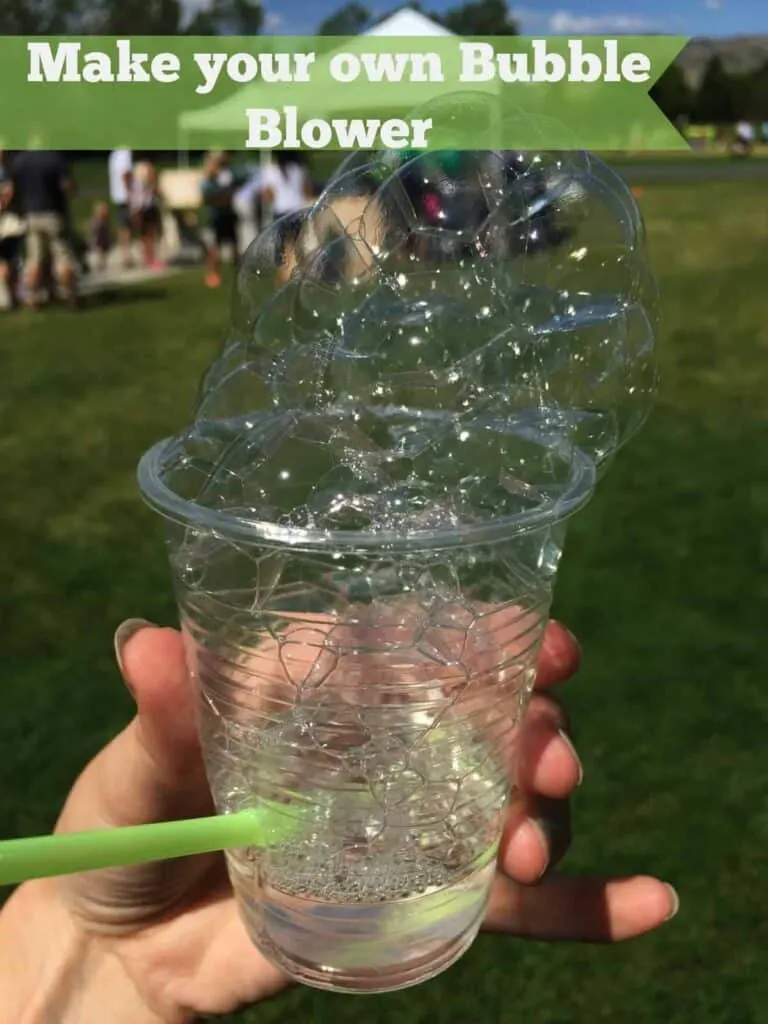
Making your own bubble blower not only allows for personalization and creativity but also provides a hands-on learning experience where students can experiment with different designs and observe the effects on bubble formation.
Learn more: How to Make your Own Bubble Blower
5. Bubble Painting
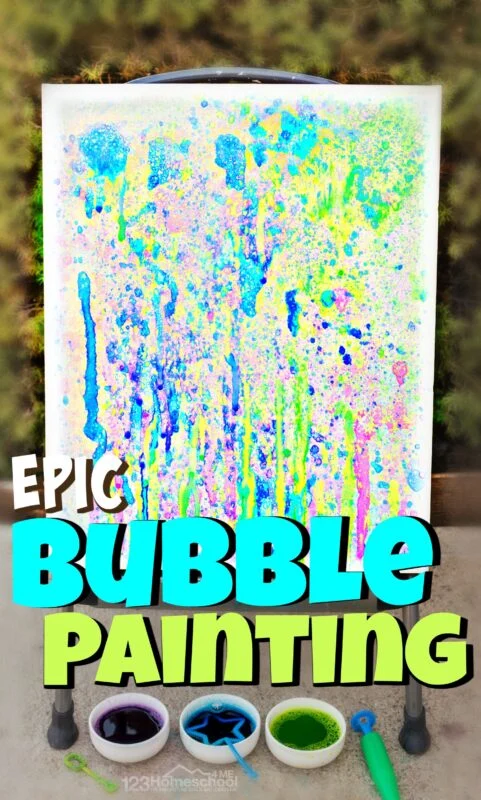
As the bubbles gently land on paper or other surfaces, they leave behind beautiful, abstract patterns and designs.
This experiment not only allows students to explore their artistic talents but also introduces them to the science behind bubbles, surface tension, and the interaction of colors.
Learn more: Bubble Painting
6. Dry Ice Bubbles
Get ready to witness a magical display of science with the captivating “Dry Ice Bubbles” experiment! This extraordinary activity allows students to explore the unique properties of dry ice and witness the formation of ethereal, fog-filled bubbles.
7. Electrostatic Soap
Step into the realm of electrostatics with the captivating “Electrostatic Soap” experiment! Prepare to witness an astonishing display as students learn about static electricity and soap.
8. Make Giant Bubbles
Creating giant bubbles encourages students to experiment, observe, and explore the scientific principles at play. It’s a hands-on experience that sparks wonder, imagination, and curiosity in learners of all ages.
9. Bubble Inside Bubble
Prepare to witness a captivating phenomenon as we explore these fascinating “Bubble Inside Bubble”! In this mesmerizing science experiment, students will discover the magic of creating one bubble within another, unlocking a visual delight.
10. Bubble Snakes
This experiment not only provides a visually captivating display but also introduces students to concepts such as airflow, bubble formation, and the properties of different bubble solutions.
11. Building With Bubbles
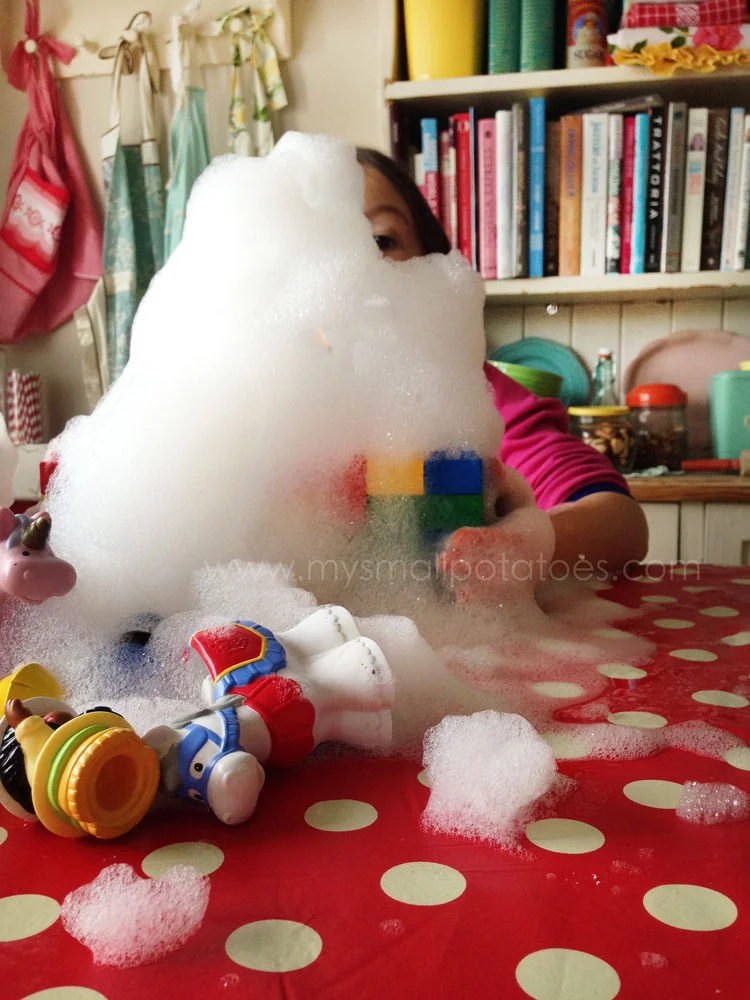
This experiment not only provides an opportunity for artistic expression but also introduces students to concepts such as surface tension, stability, and the science of bubble formation.
Learn more: Building With Bubbles
12. Rainbow Bubbles
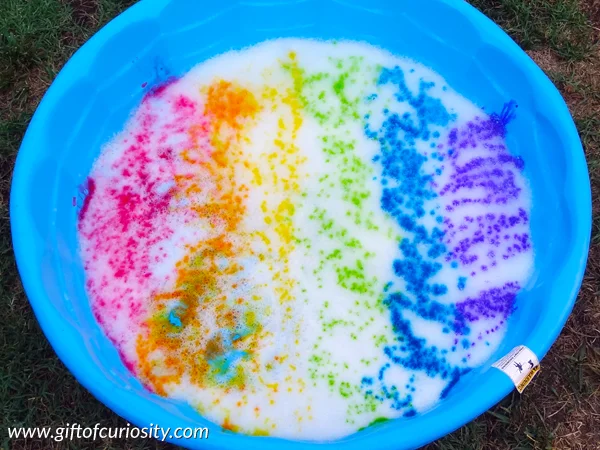
Get ready to be dazzled by the vibrant colors of “Rainbow Bubbles”! This enchanting science experiment combines the joy of blowing bubbles with the magical display of a rainbow.
Learn more: Rainbow Bubbles
13. Frozen Bubbles
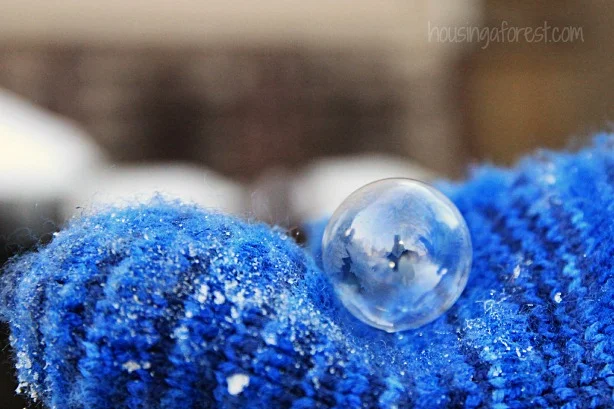
This experiment not only provides a visually stunning display but also introduces students to concepts such as the freezing point of water, the properties of ice crystals, and the effects of temperature on bubble formation.
Learn more: Frozen Bubbles
14. Make Foaming Bubbles
Get ready for some bubbly excitement with the captivating “Foaming Bubbles” experiment! In this fun and interactive activity, students will discover the joy of creating bubbles that not only float but also foam up and overflow with mesmerizing foam.
15. Watercolor Bubble Blowing Sensory Play Bin
Dive into a world of creative exploration with the captivating “Watercolor Bubble Blowing Sensory Play Bin”! This sensory-rich activity combines the joy of bubble-blowing with the magic of watercolor art.
Similar Posts:
- 68 Best Chemistry Experiments: Learn About Chemical Reactions
- Top 100 Fine Motor Skills Activities for Toddlers and Preschoolers
- Top 58 Creative Art Activities for Kids and Preschoolers
Leave a Comment Cancel reply
Save my name and email in this browser for the next time I comment.

AWESOME BUBBLE SCIENCE EXPERIMENT WITH KIDS
By: Author Agnes Hsu
Posted on Last updated: July 19, 2018
Categories Create , Latest , Learn

Scroll all the way down to watch the video below for the step-by-step video in how to create this Awesome Bubble Science Experiment With Kids and make sure to subscribe to our YouTube channel for more fun videos!

You may have seen our latest science experiment making Elephant Toothpaste with my 7 year old son who’s obsessed with science lately. He’s started a series of cool and classic science experiments kids can do right at home. We’re focusing on easy set up, clean-up, and simple materials with steps kids can do themselves, although parent supervision is always recommended with any science experiment !

See how to make this impressive bubble experiment with minimal steps and materials but tons of cool factor. And it’s not just about blowing giant bubbles . Scroll all the way down to watch the entire video from start to finish where my son explains that it’s all about surface tension!
If the learning doesn’t convince you to try this with the kids, remember this involves bubbles. Making bubbles ! What kid doesn’t like bubbles?
BUBBLE SCIENCE EXPERIMENT – MATERIALS:
- Bubble solution or you can make your own
- Surface that can be wet
- Water (we used bottled)
- Spray bottle
Before we got started we watched this awesome version of this classic bubble experiment here .

INSTRUCTIONS:
Step 1. Put your bubble solution in a container that will cover at least half the straw when added inside
Step 2. First, have your kid test out making a bubble on a dry surface. Dip your straw so it is covered at least a quarter with solution and angle it down the surface to try and blow a bubble. What happens? Well to no surprise the bubble pops quickly! But why? Read more below or watch the video to hear Kian explain it.
Step 3. Have your child liberally spray the surface with water (we used a marble board but you can use anything that can be sprayed and wiped with water like a counter top).
Step 4. Have your child repeat dipping the straw in bubble solution and then slowly blow a bubble. You want to almost touch the surface with your straw and slowly pull away while still blowing to make a nice large bubble. This time the bubble doesn’t pop!
Step 5. Now what happens when you blow a bubble in a bubble? Will it work? This is why it’s important to have your straw cover enough bubble solution to create a second bubble inside. Try it out and see by dipping your straw in more solution, slowly inserting into your first bubble and then blowing.
Now, can you make a bubble in a bubble in a bubble? How many can you make?! This is fun and challenging for kids as they start and stop and try again.
Step 6. You can also do a test with your fingers. What happens when you touch your bubble with a dry finger? It pops! Now if you wet your finger it doesn’t pop.

Why do bubbles not pop as easily when in contact with wet matter?
It’s as simple as the following science explanation:
1. Bubbles are made of a layer of soap, water and soap. Water is sandwiched in between the soap layers.
Disclosure: Some of the links in the post above are “affiliate links.” This means if you click on the link and purchase the item, we will receive a small affiliate commission. Regardless, we give our promise that we only recommend products or services we would use personally and believe will add values to our readers.

Agnes Hsu is a mom of three and has been inspiring parents and kids to get creative with easy activities and family friendly recipes for over 10 years. She shares her love for creative play and kids food to her 2MM+ followers online. Agnes' commitment to playful learning and kindness has not only raised funds for charity but also earned features in prestigious nationwide publications.
- DIY Clay Leaf Ornaments - Beautiful Christmas Craft
- Winter Photo Jar Craft - With Printable Template
- Beautiful Christmas Tree Leaf Craft
- Egg Carton Owl - Cute Recycled Craft!
Get Your ALL ACCESS Shop Pass here →
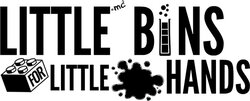
Bubbles Science Experiments (Bouncing Bubbles)
Bubble science experiments are great for teaching students about concepts like surface tension, gas formation, and properties of liquids and gases. Making bubbles is definitely on our list of simple science experiments to try. Mix up your own inexpensive bubble solution recipe and get blowing with one of these fun bubbles science experiments below.
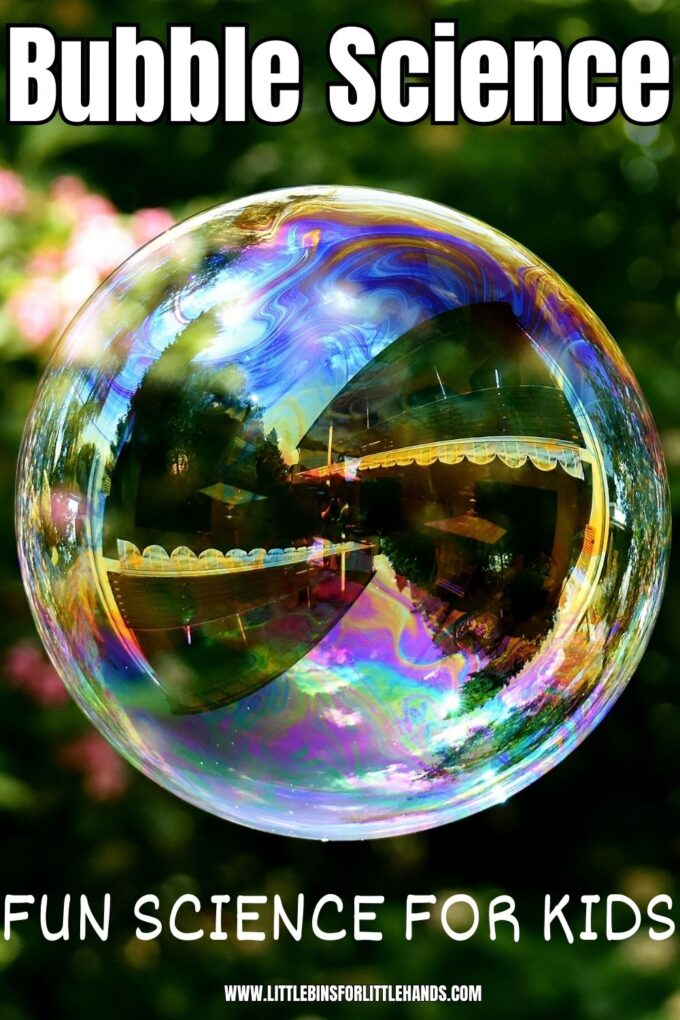
The Science of Bubbles
What’s the science behind bubbles? Bubbles comprise a thin wall of soapy film that fills with air. You can liken a bubble to a balloon in that a balloon has a thin skin of rubber filled with air.
However, when two bubbles of similar size meet, they merge together, creating the least possible surface area. Balloons, of course, can not do this!
The film that makes the bubble has three layers. A thin layer of water is sandwiched between two layers of soap molecules. Each soap molecule is oriented so that its polar (hydrophilic) head faces the water while its hydrophobic hydrocarbon tail extends away from the water layer.
When bubbles of different sizes meet, one will become a bulge onto the larger bubble. You may notice that when you get a ton of bubbles going they start to form hexagons. Bubbles will create 120 degree angles where they meet.
That means that whatever shape a bubble has when it is first formed, it will try to become a sphere. That’s because a sphere is the shape that has the least surface area and requires the least energy to achieve.
Blowing into a container of bubble solution is a great way to observe how bubbles attach to each other!

Bubble Solution Recipe
Bubble science is real and fun! Make up some homemade bubble mix and start investigating bubbles. See how to make bubble solution with glycerin or corn syrup!
You’ll also be sent weekly projects to your inbox! We respect your privacy. Unsubscribe at any time.
Try Bouncing Bubble Experiment
Can you make a bubble bounce without it breaking? This bubble experiment is fun to try!
Supplies:
- Tablespoon measure and a one-cup measure
- Paper cups and marker
- Straws, eyedropper, apple slicer (optional) and baster for blowing bubbles
- Simple glove (bouncing bubbles)
- Towel (wipe up accidents and keep surfaces clean)
How To Make A Bouncing Bubble
We used our baster to blow a large bubble onto our hand with the bubble solution.
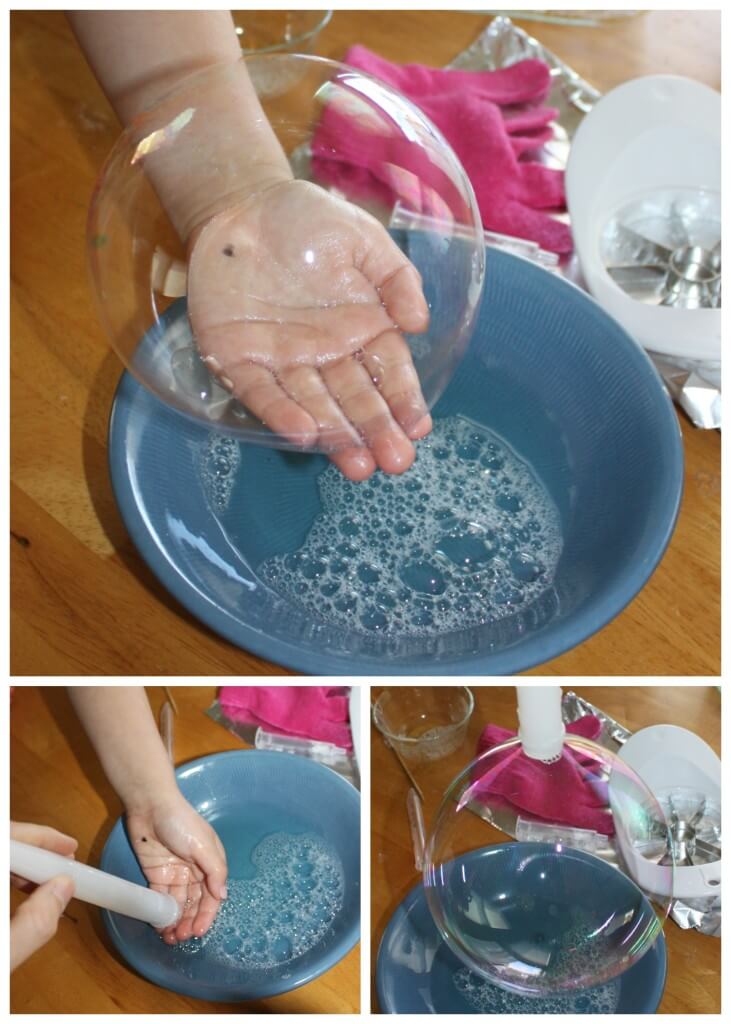
Then we used a gardening glove to bounce our bubbles gently!
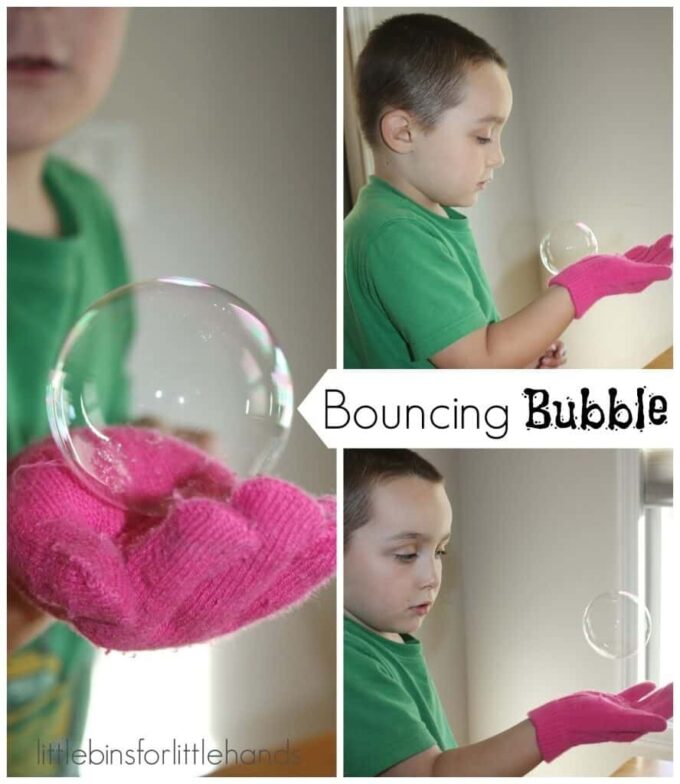
More Ways to Play with Bubbles
We also made bubbles with an apple slicer. Place it in the solution and then wave it through the air to create the bubbles. What else can you use to blow bubbles?
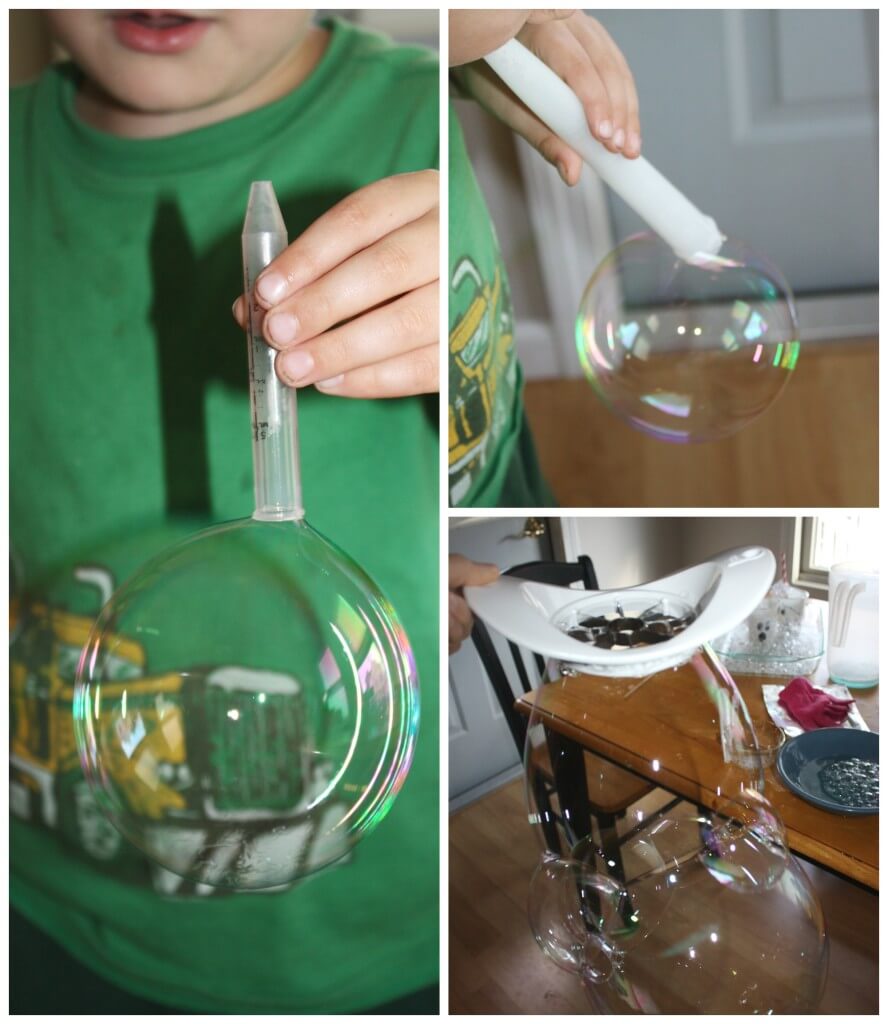
Want to stick a skewer through a bubble without popping it? Have a go!
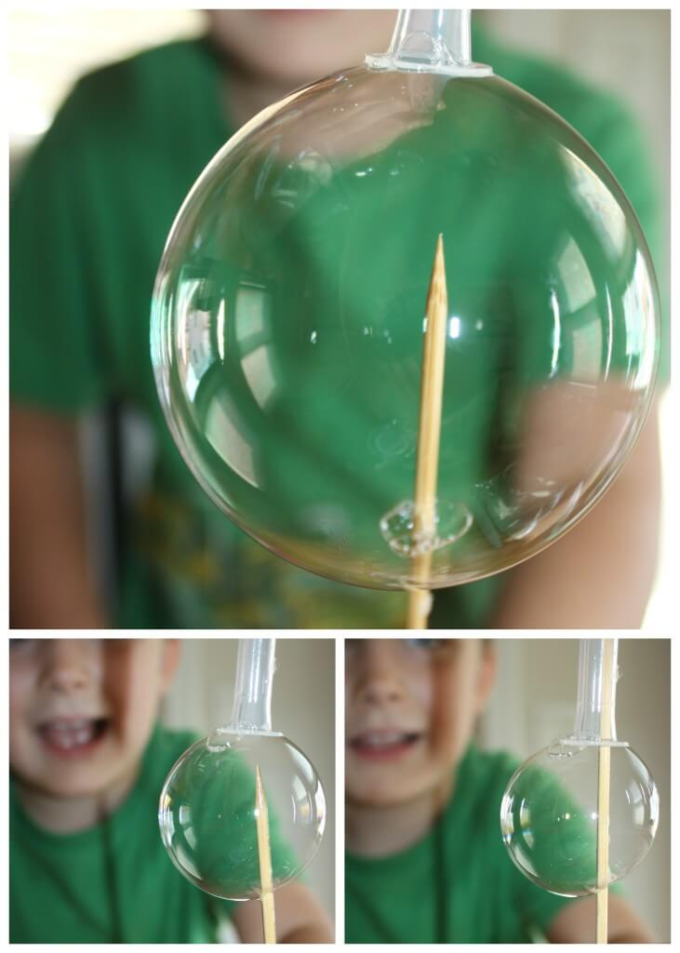
More Bubbles Science Experiments
Now you have mixed up your bubble solution, explore bubble science with one of these fun bubble activities perfect for younger students!
Geometric Bubble Wands
Can bubbles be different shapes? This special geometric bubbles activity combines a bit of math, engineering, and science as well. Build your own geometric bubble wands and explore bubble shapes.
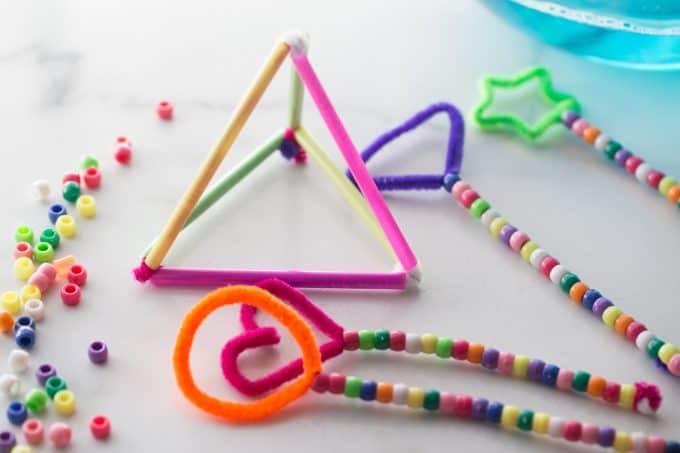
Freezing Bubbles In Winter
A fun bubble activity for winter. Blow bubbles in freezing temperatures to create ice bubbles, and observe how temperature affects the state of matter and how the bubble crystallizes when cold.
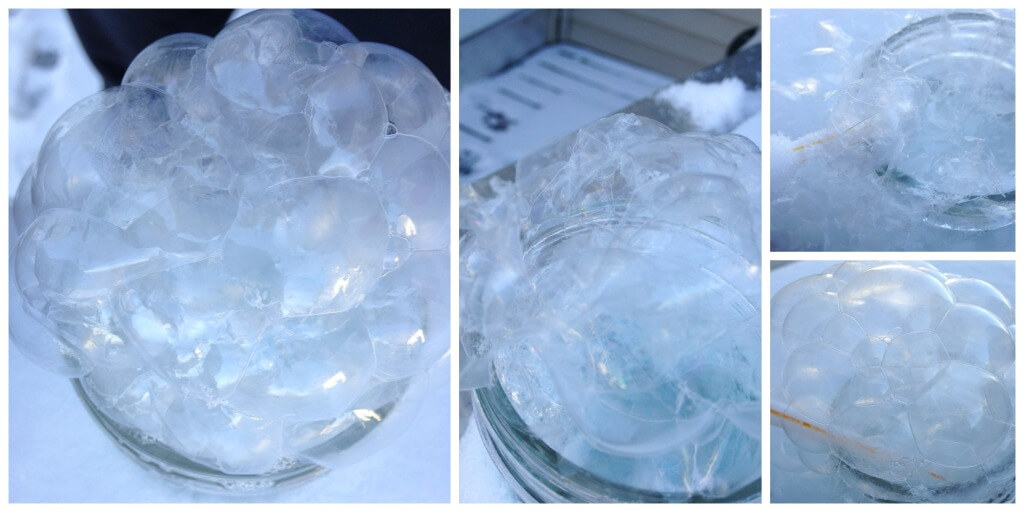
3D Bubble Shapes
Bubble blowing, homemade bubble wands, and 3D bubble structures are all an incredible way to explore bubble science any day of the year.
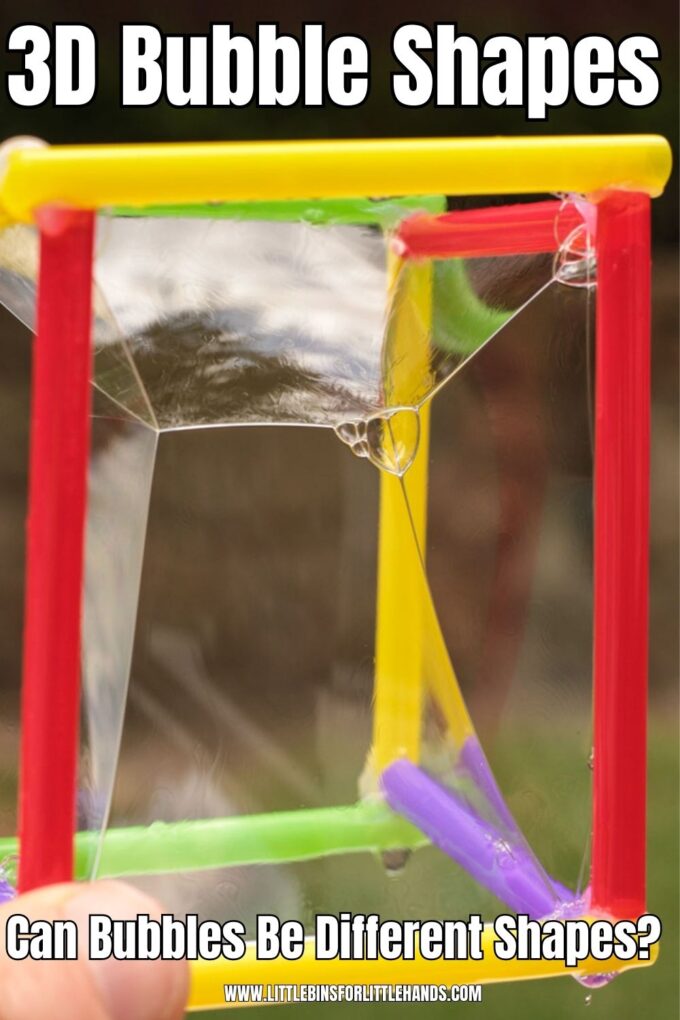
Bubble Snake
Bubbles are fascinating and fun to play with, especially when we blow them through a sock! Explore what keeps all those bubbles together to make a gigantic bubble snake.
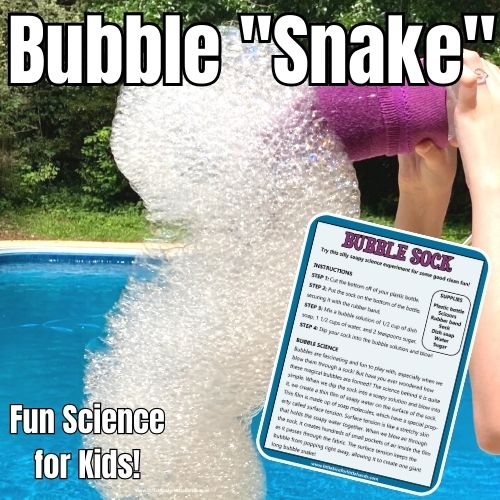
More Fun Facts About Bubbles
Bubbles are thin liquid films enclosing a pocket of air or other gas. They can be made from a water and soap mixture or other liquids with appropriate properties (including the addition of glycerin or corn syrup). The film of a bubble is made up of water molecules (in the case of soap bubbles) and is very flexible, allowing it to trap the air inside. Did you know a bubble has three “walls” like a sandwich? The outer walls are a thin layer of soap with a layer of water sandwiched in between them.

How are bubbles formed?
Bubbles are formed when air (or another gas) is blown into a liquid that contains soap or other substances that lower the liquid’s surface tension. Surface tension is the force that holds the molecules of a liquid together, creating a thin, elastic “skin” on its surface. Blowing air into the soapy water stretches the surface tension of the water mixture to form a sphere, creating a bubble.
Why are bubbles round?
Bubbles are round because the sphere is the shape with the least amount of surface area for a given volume. In nature, many things try to minimize energy, and a sphere is the most energy-efficient shape for enclosing a given volume of air.
Popping bubbles:
Bubbles can be easily popped by touching them or when they come into contact with dry surfaces. This happens because the water in the bubble film evaporates (remember the sandwich from above), causing the film to thin and break. When the bubble pops, the air inside is released into the atmosphere.
Turn It Into A Bubbles Science Project
Science projects are an excellent tool for older kiddos to show what they know about science! Plus, they can be used in various environments, including classrooms, homeschool, and groups.
Kids can take everything they have learned about using the scientific method , stating a hypothesis, choosing variables , and analyzing and presenting data.
For example:
Formulate a straightforward question or hypothesis for the project. For example: “What factors affect the size of bubbles?” or “Which soapy solution makes the most long-lasting bubbles?”
Design the experiments that will help answer the question or test the hypothesis. Keep it simple and safe for kids to perform.
Here are a few experiment ideas:
a. Bubble Solution Comparison: Compare different bubble solutions (e.g., store-bought vs. homemade) to see which produces bigger bubbles.
b. Bubble Wand Shapes: Test how the shape of the bubble wand affects the size or number of bubbles produced. Make bubble wands or 3D bubble shapes !
c. Bubble Blowing Techniques: Investigate how different blowing techniques impact the formation and longevity of bubbles.
Want to turn one of these experiments into an excellent science fair project? Check out these helpful resources.
- Science Project Tips From A Teacher
- Science Fair Board Ideas
- Easy Science Fair Projects
Helpful Science Resources
Here are a few resources to help you introduce science more effectively to your kiddos or students and feel confident when presenting materials. You’ll find helpful free printables throughout.
- Best Science Practices (as it relates to the scientific method)
- Science Vocabulary
- 8 Science Books for Kids
- All About Scientists
- Science Supplies List
- Science Tools for Kids
Printable Science Projects For Kids
If you’re looking to grab all of our printable science projects in one convenient place plus exclusive worksheets and bonuses like a STEAM Project pack, our Science Project Pack is what you need! Over 300+ Pages!
- 90+ classic science activities with journal pages, supply lists, set up and process, and science information. NEW! Activity-specific observation pages!
- Best science practices posters and our original science method process folders for extra alternatives!
- Be a Collector activities pack introduces kids to the world of making collections through the eyes of a scientist. What will they collect first?
- Know the Words Science vocabulary pack includes flashcards, crosswords, and word searches that illuminate keywords in the experiments!
- My science journal writing prompts explore what it means to be a scientist!!
- Bonus STEAM Project Pack: Art meets science with doable projects!
- Bonus Quick Grab Packs for Biology, Earth Science, Chemistry, and Physics
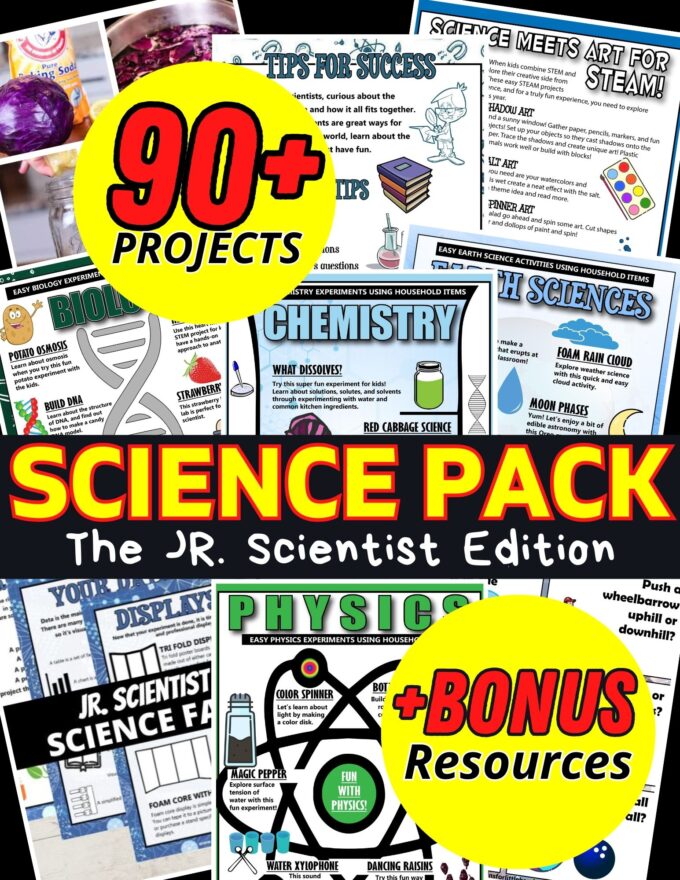
Subscribe to receive a free 5-Day STEM Challenge Guide
~ projects to try now ~.
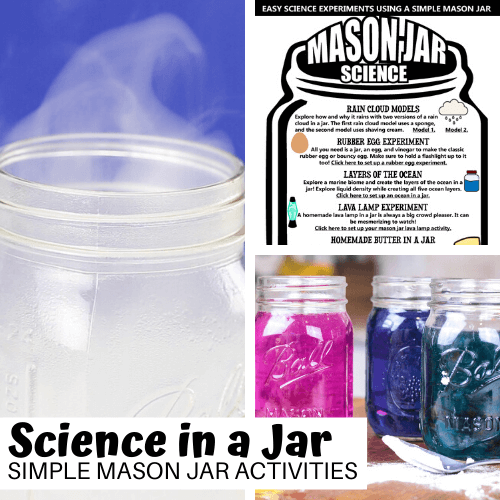

Ready to Make Circle Time Amazing?
Sign up for our FREE newsletter and receive my ebook 7 Circle Time Mistakes
Thanks for subscribing! Please check your email for further instructions.
Natural Bubble Science Experiment for Preschoolers

Did you know that blowing bubbles can be a fun, hands-on science activity for kids? This super easy recipe and bubble science experiment can be a fun way to teach kids about the scientific method.
You can do this activity at home or in school. Your little learners will have a blast making bubbles and observing how bubbles behave.

Bubble Science Experiment for Preschoolers
You can introduce this bubble experiment by building background knowledge about bubbles. Ask your kids if they have ever blown bubbles before.
Ask them how they think bubbles are made, discuss their ideas, and ask them to tell you what led them to this conclusion.
This experiment will introduce children to the scientific method through the use of bubbles.
1. Ask kids, “How do you think are bubbles made?” 2. Help kids research the topic by reading the book, How to Make Bubbles by Erika Shores 3. Make a hypothesis by asking, “What will happen if we try to make our own bubble solution and bubble wands?” 4. Test the hypothesis: Make and blow bubbles with children 5. Make a language experience chart with kids to communicate the results. Ask them, “Did it work?”

Homemade Bubble Recipe For Bubble Science Experiment
After your discussion about bubbles, read a book about bubbles. The book How to Make Bubbles by Erika Shores is perfect for preschool and kindergarten kids! Here’s a super simple homemade bubble recipe for you to try.
Ingredients for Making Natural Bubbles
- 6 cups room temperature water
- 1/2 cup light corn syrup (Karo is a popular brand here in the US)
- 1 cup dish soap (the blue Dawn brand dish soap has always worked well for me)
This bubble recipe makes enough bubble solution for a class of 16 or more children. You can adjust the measurements up or down to best suit your needs.
The secret to making good bubbles is to follow the directions exactly , don’t substitute ingredients or alter the measurements. This bubble solution works very well, just as good if not better than store bought bubbles.
If your water is hard, you should consider using distilled water from the store instead. Distilled water has different properties compared to hard water.

Easy Natural Bubble Recipe
Start by gathering the children around in your large group area and invite them to help you make the natural bubble solution together. You could also do this as a small group activity and make a small batch of bubbles with each group.
Next, add the corn syrup to the room temperature water in a large bowl or container. Let the kids stir gently until well mixed.
Then, add the dish soap and have kids stir gently again without making suds.
You will get the best results if you let your homemade bubble solution sit uncovered overnight before using.
After making bubbles with the children, talk about how it was done and ask what they think will happen next.

Blowing Bubble Predictions
The next day, after your bubble solution has settled overnight, invite your kids to make their own bubble wands with chenille stems (pipe cleaners).
Demonstrate how to twist the chenille stems to create bubble wands. You may need to assist and offer guidance for this part of the activity. This will depend on the age and abilities of your children.

Making Bubble Wands in Preschool
After each child has made their own bubble wand, invite them outside to blow bubbles. This is one of the most fun science experiments for young children!
Provide eco-friendly, disposable cups for each child to hold their own bubble solution and have fun blowing and catching bubbles.
After coming back inside, make a chart with the kids and write what they learned and share the results.
Science Curriculum for Pre-K
Let’s face it, surfing the web for random science experiments to go along with your themes or units of study is no fun. What you really need is a done-for-you science curriculum that’s designed specifically for Pre-K. But not just any science curriculum, one that’s focused on meaningful science experiences and scientific process skills that align with standards and honor the way young children learn. And what if that science curriculum also had easy to understand, step-by-step teacher instructions, lesson plans, and center activities? If all of that sounds good, then you need this science curriculum in your teacher life.
More Science Ideas

9 thoughts on “Natural Bubble Science Experiment for Preschoolers”
Pingback: POP! Bubble Wrap Number Formation » Kara Carrero
Pingback: Make some Amazing Bubble Frames! - Brain Power Boy
Pingback: Bubble Wrap Activities: Gross Motor Number Hopscotch!
Pingback: Easy DIY Homemade Bubbles and Refill Station - Crafty Mama in ME!
Pingback: Frog Mom
Pingback: Rainy Day DIY Bubble Wands - CraftCreateCalm
Pingback: Hearts for Home Blog Hop 3.24.16 - Apron Strings & other things
Pingback: Bubble Songs to Get Kids Moving ⋆ Parenting Chaos
Wow! I’d love to add this to my Bubble Experiment post!! This s an amazing list of bubble rescorces!! Thank you for sharing:)
Comments are closed.
- free-science-experiments
- bouncing-bubbles-experiment
Bouncing Bubbles Experiment!
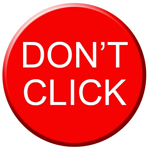
There's something magical about bubbles and there are so many great science experiments involving them.
This one's my personal favourite as the feeling of bouncing bubbles will always bring a smile to your face!
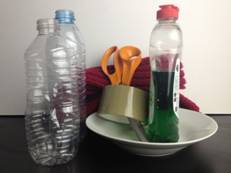
What Do I Need?
- Two water bottles
- Washing up liquid
- Woollen scarf, hat, or gloves
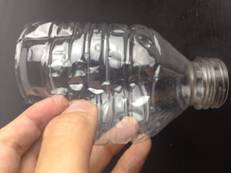
How Do I Do It?
STEP1 - First let's build our bubbles blower! Take your scissors and cut your two bottles in half and then make a slit down the side of each (as shown).
STEP2 - These vertical slits you just cut in will mean you can slot the two halves together to make your bubbles blower! Wrap a bit of tape round so it doesn't fall apart!
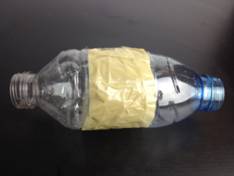
STEP3 - Next up is making your bubble mixture. There are several million different bubble recipes out there but we'll just keep things simple! Use a 'good' brand of washing up liquid. I find Fairy works best (they didn't pay me to say that!). Whatever brand you go for always use the 'unscented' or 'original' version. Mix around one part washing up liquid to three parts water and really mix it together well. I find letting my bubble mixture 'stand' overnight helps too but it'll still work just fine if you can't wait to get started!
STEP4 - Blow some bubbles! Put your bubble blower into your bubble liquid and give blowing a couple of bubbles a try!
STEP5 - It's time to make our bubbles bounce! Blow a bubble and flick it into the air. Have your woollen scarf on your hand ready and catch it! Look at the bubble bounce! If you've got more friends than me (hopefully!) go grab one of them, get something woollen each and play catch with bubbles - it's awesome!
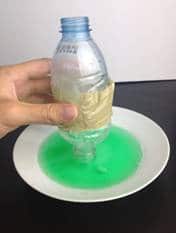
What’s Going On?
Well, first let's think about what a bubbles is?
A bubble is really just air wrapped up in a thin film of soap! Why do they pop?
They are always going to pop eventually but oil and dirt are the most common causes of bubble death!
Using woollen gloves or a scarf avoids both of these so should keep your bubbles 'alive' as long as possible!
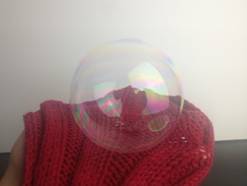
More Fun Please! - Experiment Like A Real Scientist!
- What other materials could you try?
- Tin foil, cotton socks, your t-shirt, your jumper - get creative and get experimenting!
Want A FREE Science Experiment Book?
If you like fun science experiments then you'll love this FREE Science experiment book....
It's packed full of awesome experiments you can do at home with "stuff" you've already got.
Your FREE Science experiment book is:
- 5 Star Reviewed
- Dragons' Den Approved
- Yours completely FREE.
Click Here to download your FREE copy now!
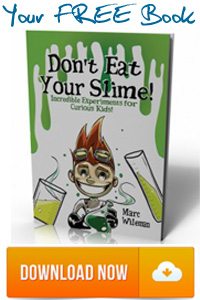
Kids Party Coming Up?
If you like fun science experiments then you’ll love the Dragons’ Den winning Sublime Science Party. Check price & availability in your area and grab your FREE Kids Party Survival Guide right now!
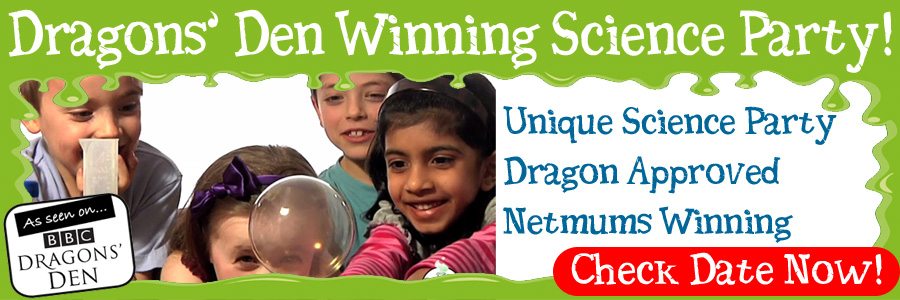
Home - About - Privacy Policy - Terms & Conditions - Facebook - Instagram - LinkedIn - Twitter - Sitemap - Blog - Contact
Copyright 2008-2023 - Sublime Science - All Rights Reserved - Registered in England and Wales, Company Number 6680269. Registered Address: The Sublime Science Lab (Unit4) Fernleigh Business Park, Blaby Rd, Enderby, Leicester LE19 4AQ - Call: 0116 380 0750
You Just Couldn't Resist!
There's some serious science behind why you just clicked!
If you'd like more awesome science experiments then enter your email address below and grab your FREE science experiment book!
You'll get your FREE copy of 'Don't Eat Your Slime', weekly 'Top Secret Science Experiment Printables' and occasional awesome offers. Happy experimenting!
(enter your email address below to get your FREE science experiment book)
YES, I Want My FREE Experiment Book!
( You'll get your FREE copy of 'Don't Eat Your Slime', weekly 'Top Secret Science Experiment Printables' and occasional awesome offers. Happy experimenting!

A Super Fun Bubble Science Experiment Kids Are Going to Love
- Post author: Sharon
- Post published: June 16, 2021
- Post category: Projects and Activities / Science / STEM
- Post comments: 0 Comments
This post contains affiliate links. By clicking on the link and making a purchase, I may receive a small compensation at no extra cost to you. I only promote products that we love and use in our homeschool. Please click here for full details on my Disclosure Policy.
Bubbles are such a fun activity. I would say kids love them, but many pets (and adults?) have fun with them too. They are so simple and enjoyable to watch as they float through the air. But have you ever thought about doing a bubble science experiment?
Several years ago, my son was taking part in our 4-H Club’s science fair. We searched through several ideas and decided to do some bubble science. He investigated the science behind bubbles and several different bubble recipes.
However, we needed to make sure the bubble science experiment was…well, scientific. You can’t just blow bubbles the exact same way every time. So, we developed a way to scientifically test bubble recipes to see which ones worked the best. At least, it was as scientific as I was going to get with an elementary-aged boy.
I’ll share links to bubble recipes, HOW we ran our bubble experiment and a little bit on the science behind bubbles.
Table of Contents
Bubble science experiment-bubble recipes, the experiment, supplies needed, how to conduct the bubble science experiment, analyzing your bubble science experiment data, about the ingredients in bubble solutions.
If you search the internet, you will find many different sites with homemade bubble recipes. I want to help you out with 4 of the most common bubble recipes you can use for your bubble science project. All are great recipes to use for your science experiment. Plus, they are great for other activities.
How to Make Homemade Giant Bubbles that will Blow Your Mind (Happy Hooligans)- This recipe is strong enough to make giant bubbles. We have used it before. You will add corn starch, baking powder, and glycerin to the soap and water mixture for the solution. Check out this recipe and give it a try.

How to Make Homemade Bubbles (The Artful Parent)- With three simple ingredients, your kids will have homemade bubbles. You only need sugar, water, and soap. Pretty simple.
Homemade Bubbles (Saving Cent by Cent)- Here is another simple recipe. However, this recipe adds only corn syrup to the main soap base.
DIY Unpoppable Bubbles (Learning Resources)- If your kids want to bounce bubbles with their hands, this is a good recipe. My kids, even at 12 and 14, had so much playing around with this one. It is an excellent recipe to test in your bubble experiment.

Bubble Science Experiment
To do your own bubble science experiment at home, take a look at the process we came up with to make this an actual scientific activity.
To test different bubble recipes to see which bubble solution works the best (floats the longest and makes the most bubbles in one “blow”).
- Homemade bubble solutions labeled Bubble Solution 1, Bubble Solution 2, etc.
- Bubble wands.
- Watch, phone, or another device that has a stopwatch.
- Bubble Science Experiment Chart.

Now that you have your supplies let’s begin.
- Dip the bubble wand in the first bubble solution.
- Place the wand in front of the fan that is blowing at low speed. This way, the bubbles are always blown with the same strength and consistency.
- Once the bubble wand is placed in front of the fan, begin the stopwatch and start counting bubbles. It would be best if you had a helper for this activity.
- Stop the stopwatch when the last bubble pops.
- Record the time on the BUBBLE SCIENCE CHART and approximately how many bubbles. I say “around how many bubbles” because it may be challenging to count them if many bubbles come out at once. Do the best you can.
- Repeat multiple times for each bubble solution and record the results. You can repeat the experiment as many times as you want and for as many bubble solutions as you wish. I put extra spaces to allow you to adjust the activity to fit your family’s needs.
- Once you have tested all your solutions, it is time to analyze your results!

Depending on your child’s age, you can analyze the results in different ways.
- If you have younger kiddos, look at the times and amount of bubbles and eyeball what solution lasted the longest and had the most bubbles MOST of the time.
- With older kids, you could have them calculate the averages of the times and bubble amounts.
- Compare the recipes by the ingredients and discuss which items you think helped the bubbles perform well.
{You might also like to experiment with these DIY Clay Recipes and see which works best.}

Signup for homeschool support and receive your FREE list of 36 Fun Activities to do with Kids!
You can unsubscribe anytime. For more details, review our Privacy Policy.
You have successfully joined our subscriber list. Click HERE to download your FREE Fun Activities to do with Kids!
The Science of Bubbles
Now to make the project even more scientific, let’s look at some of the science behind bubbles. It is actually kind of interesting.
First off, we can make bubbles just by blowing in water. The air we blow out creates bubbles in the water molecules. We can make lots of bubbles that way. However, the bubbles pop pretty quickly, and they certainly don’t float off in the air. No fun.
If, however, we add dish soap to water, we get a better result.
Well, soap creates a film that can wrap around water and air, which is how we make bubbles. It is also why we use soap to remove dirt. The soap attaches to the dirt so it can be washed away.
Bubbles are formed when we blow air into the soapy solution. A soap film traps the air. As we blow, the soap expands, and because soap has elasticity, it stretches and expands to make the bubble bigger.
If you want to learn even more, check out the Science of bubbles at Science World. It is where I got my information. They go into a lot more detail and have diagrams, too.
So, each of the bubble recipes has slightly different ingredients. What is the purpose of each of the ingredients? Let me explain.
Sugar, glycerin, corn syrup, and corn starch – From all the information I found, all these ingredients keep bubbles from drying out. If the water evaporates too quickly in bubbles, they will pop. All of these ingredients slow down the evaporation, so the bubbles stick together longer.
Baking powder – Baking powder is used in baking because it releases carbon dioxide. In this chemical process, bubbles are released, making baked goods rise. I found that this creates a higher ph level and will then make your bubbles last longer too.
A cool thing to try is to test if one ingredient or different combinations of these ingredients work better. You have lots of options to try!

Phew, there are so many fun options with this bubble science experiment. Grab your ingredients, your Bubble Science Experiment Chart , the kids, and start experimenting! It will undoubtedly make for a fun afternoon.
Need more science ideas??? Check out My Teaching Library . They have science resources for Pre-K through 12th grade. It is an awesome site.
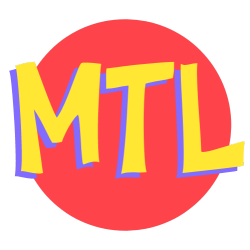
Happy Homeschooling!
You Might Also Like

An Easy Online Coding Class for Kids

Homeschool Science with NatureGlo’s eScience

Fun Activity for Teens: Design a Game
Leave a reply cancel reply, privacy overview.

COMMENTS
From understanding surface tension and light interference to exploring gas laws and fluid dynamics, bubbles turn simple observations into profound learning experiences. These engaging and educational, hands-on bubble science experiments are perfect for classroom activities, science fairs, or simply as a fun way to explore the wonders of bubbles.
We suggest letting your bubble solutions rest for 24 hours for best results. Test your solutions with your bubble wand. Try holding a bubble in your hand. Put on the glove. ... You can create a science fair project by identifying a variable, or something that changes, in this experiment. Let's take a look at some of the variable options that ...
Scroll all the way down to watch the video below for the step-by-step video in how to create this Awesome Bubble Science Experiment With Kids and make sure to subscribe to our YouTube channel for more fun videos! ... Put your bubble solution in a container that will cover at least half the straw when added inside. Step 2. First, have your kid ...
Bubble science experiments are great for teaching students about concepts like surface tension, gas formation, and properties of liquids and gases. Making bubbles is definitely on our list of simple science experiments to try. Mix up your own inexpensive bubble solution recipe and get blowing with one of these fun bubbles science experiments below.
Go outside and test your bubble solutions. Blow a bubble and catch it on your wand. Immediately start the stopwatch and time how long the bubble lasts. This will take some practice, so try it out on some extra solution before you start! Repeat the experiment as many times as possible for each solution. Record your data in a data table:
Homemade Bubble Recipe For Bubble Science Experiment. After your discussion about bubbles, read a book about bubbles. The book How to Make Bubbles by Erika Shores is perfect for preschool and kindergarten kids! Here's a super simple homemade bubble recipe for you to try. Ingredients for Making Natural Bubbles. 6 cups room temperature water
Mix around one part washing up liquid to three parts water and really mix it together well. I find letting my bubble mixture 'stand' overnight helps too but it'll still work just fine if you can't wait to get started! STEP4 - Blow some bubbles! Put your bubble blower into your bubble liquid and give blowing a couple of bubbles a try!
Experiment. Make up a batch of Bouncing Bubble Solution with the ingredients listed to the right. Making your bubble solution at least 24 hours in advance and allowing it to sit undisturbed will allow the bonds in your bubble solution to strengthen.
Bubble Science Experiment. To do your own bubble science experiment at home, take a look at the process we came up with to make this an actual scientific activity. The Experiment. To test different bubble recipes to see which bubble solution works the best (floats the longest and makes the most bubbles in one "blow"). Supplies Needed
Below you will find simple bubble experiments for the little ones and some more challenging bubble projects for older scientists as well. Bubble Discoveries. Discover how to make glow-in-the-dark bubbles, how to freeze bubbles, how to create square bubbles, how to light bubbles on fire, and even how to hold bubbles in your hands.